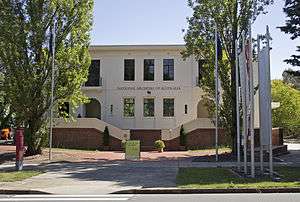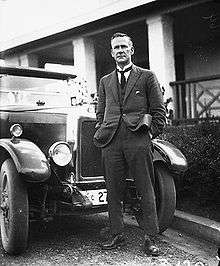National Archives of Australia
 | |
| Agency overview | |
|---|---|
| Formed | March 1961 |
| Preceding agency | |
| Jurisdiction | Government of Australia |
| Headquarters |
Queen Victoria Terrace, Parkes, ACT 35°18′18″S 149°07′50″E / 35.304877°S 149.130574°ECoordinates: 35°18′18″S 149°07′50″E / 35.304877°S 149.130574°E |
| Employees | 410[1] |
| Annual budget | A$87.87 million (2017–18) |
| Minister responsible | |
| Agency executive |
|
| Parent agency | Attorney-General's Department |
| Key document |
|
| Website | naa.gov.au |
The National Archives of Australia is an Australian Government agency that collects, preserves and encourages access to important Australian Government records. It describes itself as the memory of the nation.
The Archives’ collection of 40 million items traces events and decisions that have shaped the nation and the lives of Australians. Visitors are welcome to explore the collection, online or in person.
Established under the Archives Act 1983, the National Archives reports to its Minister, the Attorney-General. Like all government agencies, it is accountable to the Australian Parliament. The National Archives of Australia Advisory Council provides advice to the Minister responsible for the Archives and the Director-General.
Under the Act, the National Archives has two main roles:
- to collect and preserve Australia’s most valuable government records and encourage their use by the public
- to promote good information management by Commonwealth government agencies, especially in meeting the challenges of the digital age.
In addition to caring for its collection, the National Archives develops and tour exhibitions, publishes books and guides to the collection and delivers educational programs.
History

After World War I the Commonwealth National Library (later National Library of Australia) was responsible for collecting Australian Government records. The library appointed its first archives officer in 1944.
In March 1961 the Commonwealth Archives Office formally separated from the National Library of Australia and was renamed as the Australian Archives in 1975.
The Archives Act 1983 gave legislative protection to Commonwealth government records for the first time, with the Australian Archives responsible for their preservation.
The agency was renamed the National Archives of Australia in February 1998.
Collections
The National Archives of Australia’s collection of 40 million items covers records pertaining to the government of Australia, including Federation, Governors-General, Prime Ministers, Cabinet and Ministers.
Among the most popular with the public are defence service and immigration records which often contain valuable family history.
The Archives' repositories are not open to the public but items can be requested for digitisation or for viewing in reading rooms. Most records over 26 years old (gradually reducing to 20 years) are released for public access on request. However some have certain information exempted from access. These exemptions may include documents relating to defence and security and sensitive personal information.
Cabinet notebooks have a longer closed period, gradually decreasing from 50 years to 30 years by 2021. Access to items of cultural sensitivity to Indigenous Australians may also be restricted.
Notable collections

There are several notable collections held by the National Archives of Australia. They include:
- founding documents, including the Royal Commission of Assent, the Constitution Act and other records created when the six colonies federated to create the Commonwealth of Australia on 1 January 1901
- World War I and World War II service records. Some 376,000 service records for men and women who served in World War I have been digitised and are available online at the Discovering Anzacs website.
- the Griffin drawings – Walter Burley Griffin and Marion Mahony Griffin's winning entry for the design of Australia's Federal Capital
- Mildenhall glass plate photographs taken by government photographer Jack Mildenhall – the 7700 images record Canberra during the 1920s and 1930s
- more than 34,000 immigration photographs
- copyright, patent and trademark registration records documenting Australian creativity and ingenuity.
Facilities
The Archives’ National Office is in Canberra. It has temporarily been relocated to Old Parliament House until the end of 2018 when it will return to East Block. In 1998 the Canberra reading room, galleries and public areas of National Archives moved into a heritage listed building East Block in the Parliamentary Triangle. The building, one of the national capital's original offices, was built in 1926 beside the Provisional Parliament House. Over the years East Block housed various government departments and served as Canberra's first post office and telephone exchange.
National Archives reading rooms, repositories and offices are also located in each state capital and in Darwin.
Australian Series System
In 1966, Peter Scott of the Commonwealth Archives Office (predecessor to the National Archives of Australia) developed the Australian Series System in his paper "The Record Group Concept: A Case for Abandonment"[2]. This system represented a change in traditional archival theories of provenance that groups records by the more flexible record series rather than the record group which required all records to be filed under only one creating agency (business, government agency, individual, etc.). The new system recognizes that creating agencies change names, split and dissolve over time and provides a flexible framework to arrange their records across the different agencies which all share the same organizational content. These record series are relational in that they are linked to their historical creating agencies in their various forms to reflect changes in organizational structure over time[3].
National directors
- 1944–68 – Ian MacLean, Chief Archivist
- 1968–70 – Keith Penny, Chief Archivist
- 1970–71 – Keith Pearson, Director, Commonwealth Archives Office
- 1971–75 – John Dunner, Director, Commonwealth Archives Office
- 1975–84 – Robert Neale, Director-General, Australian Archives
- 1984–89 – Brian Cox, Director-General, Australian Archives
- 1990–2000 – George Nichols, Director-General, Australian Archives/National Archives of Australia
- 2000–03 – Anne-Marie Schwirtlich, acting Director-General, National Archives of Australia
- 2003–11 – Ross Gibbs, Director-General, National Archives of Australia
- 2011–Jan 2012 – Stephen Ellis, acting Director-General, National Archives of Australia
- 2012–present – David Fricker, Director-General, National Archives of Australia
See also
References
- ↑ National Archives of Australia Annual Reports 2016-2017 (Report).
- ↑ Scott, Peter (October 1966). "The Record Group Concept: A Case for Abandonment". The American Archivist. 29(4): 493–504 – via JSTOR.
- ↑ Cook, Terry (Spring 1997). "What is Past is Prologue: A History of Archival Ideas Since 1898, and the Future Paradigm Shift". Archivaria. 43: 17–63.
External links
| Wikimedia Commons has media related to National Archives of Australia. |